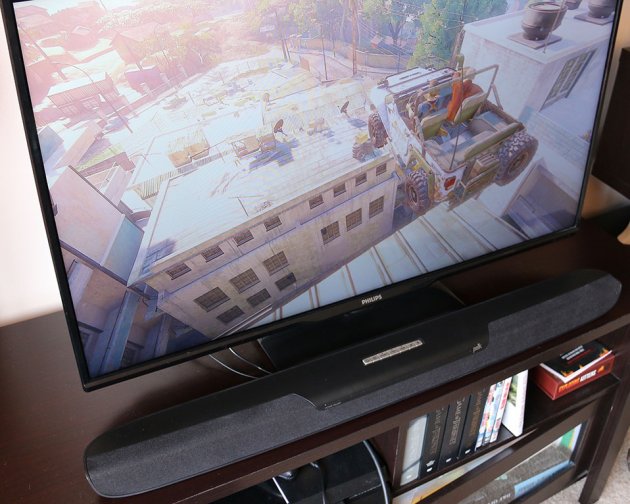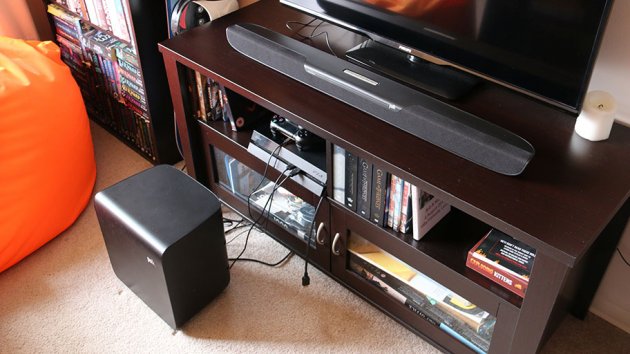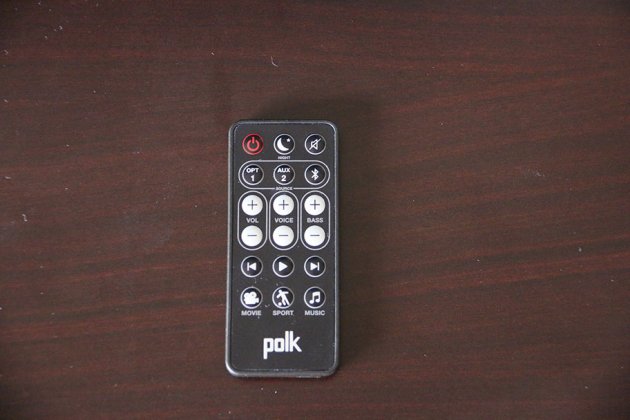

The Master Switch


The Master Switch
At some point, the engineering and marketing departments at Polk Audio must have had a conversation that went something like this:
Marketing: Hi, guys. Thanks ever so much for designing this new MagniFi soundbar thing. We love the included subwoofer, too, but we have a concern.
Engineering: What is it?
M: We’re worried that our customers will get annoyed using it.
E: Annoyed? What you talking about? This thing was honed to perfection in our secret laboratory. It’s the product of countless hours of research and development. It is flawless. It is perfect. It is -
M: Your lab isn't secret. It’s just down the hall. But that’s not the point. We’re worried about how loud the thing is. Because, guys, it’s really loud. We know our customers like loud things, but they might get annoyed at having to constantly turn down the volume when their neighbours complain. Is there anything we can do about that?
E: Yes. It’s called a volume control. They’ll figure out how to use it eventually.
M: OK, yeah, but work with us here. What if there was a button that did it for you. A…we don’t know, a Night Mode Button. Something that killed the bass frequencies and raised the dialogue.
E: Impossible. We don’t have the time. We’re stretched thin as it is, what with Norbert off sick, and we can’t possibly be expected to drop everything because you think people are too lazy to…
M: Well, if you can’t do it, all you had to do was say so.
E: …Fine. Give us a few days.
And so it came to pass that the sleek, already brilliant MagniFi Soundbar and accompanying sub got the feature it absolutely didn’t need but which is a pleasure to use anyway. It doesn’t push the boundaries for soundbar-based audio, but it does a hell of a lot of good with existing tech and a few very bright ideas. And when there's a button on the product designed to make the sound quieter at a single push, you know this thing will be monstrously loud...

The soundbar is a gently-curved, 38 inch number that will fit comfortably under most TVs. It has a row of buttons on top, although you’re almost certainly not going to use them, thanks to the excellent remote (of which much more anon). The subwoofer is a big, blocky, down-firing brute, just over a foot high.
Setting the two up is easy-as. The recommended connection for the soundbar to your system is via an included optical cable; we arranged things by connecting it to a Playstation 4, which worked without any trouble. If you don’t have an optical connection, there are Aux and USB ports on the back as well (although no HDMI, which is worth being aware of). The subwoofer is entirely wireless, save for the power cable, and with no controls on the unit itself, all you need to do is pair it with the bar using Bluetooth, which is simple. In fact, the most complicated part of the entire procedure was actually working out how to position the setup in our already complicated tangle of wires behind the TV – hardly something we can blame the bar for.
A row of lights along the front of the unit indicate things like power status and volume. We were wary about this first, as it seemed to be a somewhat crude system, but it is both simple and intuitive. In terms of setup and sheer ease-of-use, the system gets top marks.

Normally at this point of a review, we spent some time talking about the sound quality. And we will, just not yet. Because we want to talk about the remote first.
It’s genius.
We mean that. Honest, simple genius. It has absolutely everything you need to control the soundbar in one place. It is laid out logically, clearly, and with absolutely no room for misinterpretation. It is how we wish all remotes would look.
There are three buttons that allow you to select your audio source, as well as a mute and power button. There’s the aforementioned Night Mode switch which makes things acceptable to your neighbours (and which, just in case you’re not totally clear, is indicated by a moon and star). You get track skip buttons, as well as three preset buttons for movies, sports, and music.
The real genius bit, however, is in the centre, where you have not one but three different volume controls. One handles the overall volume of the unit, while another handles the dialogue level. The final one allows you to get the exact level of bass you want from the subwoofer. Under normal circumstances, three separate controls might cause confusion, but the results here is that you are able to get the exact balance you want with minimal effort.
One danger is that the remote is very tiny, about the size of your palm, so losing it between the couch cushions is a real problem. On more than one occasion, we lost track of it for a few minutes. It’s just as well we found it again, or the nice folks at Polk who leant us the unit might have some pointed questions. By the way, you can also program your universal remote to operate the bar, although why you'd want to abandon Polk's little number for a clunky, cluttered remote is beyond us.

Onto the sound. It can be summed up in one word: loud. Actually, two words: holy hell.
At top volume, the system generates enough power to rattle the windows and knock birds out of nearby trees. Even when the sound is turned down, it’s an immediate and visceral upgrade to your TV audio.
We don’t normally like to namecheck specific artists or movies when we review products, the rationale being that our readers might not enjoy the same things we do, but in this case, we're going to make an exception. When a videogame as cinematic as Uncharted 4 releases on the same day we receive a soundbar, you can be damn sure we’re going to use it for professional purposes.
We loved the sound of this thing. Explosions and gunshots were meaty and satisfying, and it was easy to discern the dialogue even in the middle of a psychotic car chase. The clicks and clacks of reloading rifles and the cheerful bong sound whenever we collected another treasure were bright and detailed. The system offers some of the most exciting sound we’ve ever heard, and it made playing games and watching Netflix and catching up on the NBA playoffs a joy.
That’s not to say it doesn’t have problems, however. While the sound is good, it isn’t very subtle. It’s going in with a hacksaw instead of a scalpel. This isn’t too big an issue, as the audio quality is excellent, but if you’re hoping for precision adjustments, you may want to look elsewhere. We also felt the three presets mentioned earlier didn’t really do the job. They were perfectly acceptable, but they all required a couple of tweaks to get what we wanted.

Despite its lack of subtlety, there’s no question that the MagniFi soundbar system is a cut above. It offers extraordinary value for money, delivering both an excellent bar and a very capable subwoofer in one package. Its design and ease-of-use is extraordinary, and it deserves its place as one of the top models on the market. If you want to supercharge your sound without committing to a full 5.1 or 7.1 system, then you should absolutely pick this up.
See the MagniFi Soundbar on Amazon
Superlative sound, great design
Lacks subtlety
When you want an easy upgrade to your sound with zero hassle
While it doesn’t have nearly the bass power of the MagniFi system, it’s still an exceptional little package which is particularly good with movies. The design is by Andrew Jones, a legendary speaker maker, so the pedigree is impeccable.
If you can deal with living inside the closed SONOS ecosystem, you’ll find a genuinely fantastic (albeit pricey) soundbar that offers outstanding detail in its audio.
| Soundbar | Price | Weight | Dimensions | Wattage | Chan. | HDMI In | Bluetooth | Sub |
|---|---|---|---|---|---|---|---|---|
| Polk Audio Magnifi | $499 | 4.75lbs | 38" x 3" x 2" | 300 | 2.1 | 0 | Yes | Yes |
| Pioneer SP-SB23W | $330 | 13.2lbs | 36" x 4.7" x 4" | 218 | 2.1 | 0 | Yes | Yes |
| SONOS PLAYBAR | $689 | 11.9lbs | 35.4" x 3.3" x 5.5" | Unknown | 2 | 0 | No | No |